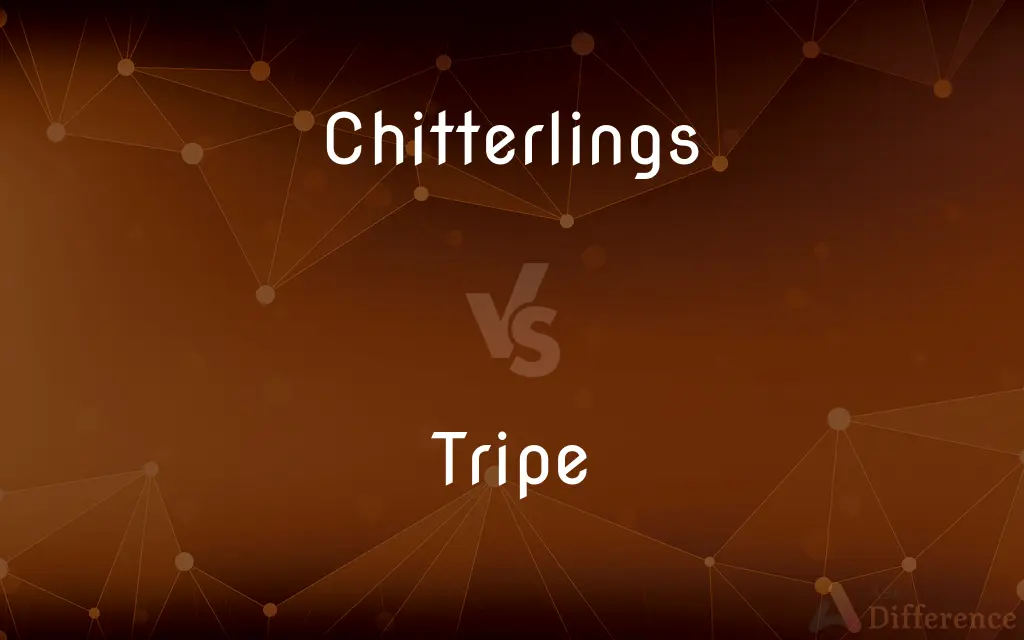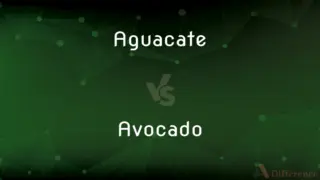Chitterlings vs. Tripe — What's the Difference?
By Tayyaba Rehman — Updated on January 14, 2024
Chitterlings are the cleaned and cooked small intestines of a pig, while tripe is the edible lining from the stomachs of various farm animals, most commonly cows.

Difference Between Chitterlings and Tripe
Table of Contents
ADVERTISEMENT
Key Differences
Chitterlings, often referred to as "chitlins," are made from the small intestines of pigs and are a traditional dish in many southern U.S. cuisines. Tripe, on the other hand, comes from the stomach lining of ruminant animals like cows, sheep, or goats.
Preparation of chitterlings involves thorough cleaning and cooking, often boiled and sometimes fried. Tripe is also cleaned meticulously and is typically stewed, braised, or included in soups.
Chitterlings have a distinctive, somewhat pungent aroma and a unique, chewy texture. Tripe has a milder scent compared to chitterlings and offers a tender texture when cooked properly.
In terms of culinary use, chitterlings are a staple in soul food and are often eaten with vinegar or hot sauce. Tripe is used globally in various cuisines, including in Italian, Mexican, and Chinese dishes.
Nutritionally, both chitterlings and tripe are high in protein, but they must be prepared properly due to their origin in the digestive system, which can harbor bacteria.
ADVERTISEMENT
Comparison Chart
Source
Small intestines of pigs
Stomach lining of ruminants like cows
Preparation
Thorough cleaning, boiled or fried
Cleaned, stewed or braised
Texture
Chewy
Tender
Culinary Use
Common in southern U.S. and soul food
Used in diverse cuisines globally
Aroma
Distinctive, pungent
Milder
Compare with Definitions
Chitterlings
Cooked small intestines of pigs.
Chitterlings are often served during special family gatherings.
Tripe
Edible lining from the stomachs of cows.
Tripe is commonly used in menudo, a Mexican soup.
Chitterlings
Often eaten with hot sauce or vinegar.
I prefer my chitterlings with a bit of vinegar on top.
Tripe
Used in various international cuisines.
In Italy, tripe is often cooked with tomatoes and herbs.
Chitterlings
Require thorough cleaning before cooking.
Cleaning chitterlings properly is essential for safety.
Tripe
Offers a tender texture when cooked properly.
The tripe was so tender in the stew, it melted in my mouth.
Chitterlings
A traditional southern U.S. delicacy.
Chitterlings have a long history in soul food cuisine.
Tripe
High in protein and nutrients.
Tripe is not only flavorful but also nutritious.
Chitterlings
Known for their distinctive aroma.
The aroma of chitterlings is quite strong when they're being cooked.
Tripe
Has a milder scent compared to chitterlings.
Tripe has a less intense smell than other offal.
Chitterlings
Chitterlings (), sometimes spelled chitlins or chittlins are the small intestines of domestic animals, especially when cooked and eaten. They are usually made from pigs' intestines.
Tripe
Tripe is a type of edible lining from the stomachs of various farm animals. Most tripe is from cattle, pigs and sheep.
Chitterlings
Small intestine, boiled and fried, usually of a pig. Sometimes prepared with hog maws.
Tripe
The rubbery lining of the stomach of cattle or other ruminants, used as food.
Chitterlings
Plural of chitterling
Tripe
(Informal) Something of no value; rubbish.
Chitterlings
The smaller intestines of swine, etc., fried for food.
Tripe
The lining of the large stomach of ruminating animals, when prepared for food.
Chitterlings
Small intestines of hogs prepared as food
Tripe
The entrails; hence, humorously or in contempt, the belly.
Tripe
Something foolish or valueless, especially written works and popular entertainment (movies, television).
Tripe
An edible lichen, especially rock tripe.
Tripe
(pejorative) That (what has just been said) is untrue.
Tripe
The large stomach of ruminating animals, when prepared for food.
How say you to a fat tripe finely broiled ?
Tripe
The entrails; hence, humorously or in contempt, the belly; - generally used in the plural.
Tripe
Lining of the stomach of a ruminant (especially a bovine) used as food
Tripe
Nonsensical talk or writing
Common Curiosities
Is tripe a popular ingredient worldwide?
Yes, tripe is used in various cuisines around the world.
How long does it take to cook chitterlings?
Chitterlings can take several hours to cook until tender.
Are there different types of tripe?
Yes, including honeycomb tripe and blanket tripe, among others.
What's the nutritional value of chitterlings?
Chitterlings are high in protein but should be eaten in moderation due to their high cholesterol content.
Is it safe to eat chitterlings?
Yes, when cleaned and cooked properly, chitterlings are safe to eat.
Can tripe be eaten raw?
Tripe should be cooked thoroughly before consumption.
What are common spices used with chitterlings?
Common spices include garlic, onion, and bay leaves.
Can chitterlings be frozen?
Yes, they can be frozen for later use.
Are chitterlings and tripe considered offal?
Yes, both are categorized as offal, which refers to the entrails and internal organs of animals.
How do you reduce the smell when cooking chitterlings?
Proper cleaning and adding aromatic spices can help reduce the smell.
Is tripe a budget-friendly ingredient?
Yes, tripe is generally affordable compared to other cuts of meat.
Do chitterlings have a strong taste?
They have a distinctive taste that can be enhanced with seasonings.
Can tripe help in digestion?
Tripe is easily digestible but doesn't specifically aid in digestion.
What's a famous dish made with tripe?
Menudo, a Mexican soup, and Italian Trippa alla Romana are popular dishes.
Is tripe available in grocery stores?
Tripe is available in many grocery stores, especially those with a diverse meat selection.
Share Your Discovery

Previous Comparison
Wyrm vs. Wyvern
Next Comparison
Aguacate vs. AvocadoAuthor Spotlight
Written by
Tayyaba RehmanTayyaba Rehman is a distinguished writer, currently serving as a primary contributor to askdifference.com. As a researcher in semantics and etymology, Tayyaba's passion for the complexity of languages and their distinctions has found a perfect home on the platform. Tayyaba delves into the intricacies of language, distinguishing between commonly confused words and phrases, thereby providing clarity for readers worldwide.













































